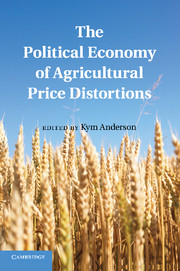Book contents
- Frontmatter
- Contents
- List of Figures
- List of Tables
- Contributors
- Foreword
- Preface
- Abbreviations and Acronyms
- PART ONE Introduction
- PART TWO CONCEPTUAL FRAMEWORKS AND HISTORICAL ORIGINS
- Part Three Political Econometrics: the Past Fifty Years
- NINE Agricultural Price Distortions and Stabilization
- TEN Why Governments Tax or Subsidize Agricultural Trade
- ELEVEN Impacts of Ideology, Inequality, Lobbying, and Public Finance
- TWELVE Agricultural Trade Interventions in Africa
- THIRTEEN Trade Agreements and Trade Barrier Volatility
- FOURTEEN Constitutional Rules and Agricultural Policy Outcomes
- Appendix: Coverage and Distribution of Assistance across Countries and Products, 1955–2007
- Index
- References
TWELVE - Agricultural Trade Interventions in Africa
Published online by Cambridge University Press: 05 July 2011
- Frontmatter
- Contents
- List of Figures
- List of Tables
- Contributors
- Foreword
- Preface
- Abbreviations and Acronyms
- PART ONE Introduction
- PART TWO CONCEPTUAL FRAMEWORKS AND HISTORICAL ORIGINS
- Part Three Political Econometrics: the Past Fifty Years
- NINE Agricultural Price Distortions and Stabilization
- TEN Why Governments Tax or Subsidize Agricultural Trade
- ELEVEN Impacts of Ideology, Inequality, Lobbying, and Public Finance
- TWELVE Agricultural Trade Interventions in Africa
- THIRTEEN Trade Agreements and Trade Barrier Volatility
- FOURTEEN Constitutional Rules and Agricultural Policy Outcomes
- Appendix: Coverage and Distribution of Assistance across Countries and Products, 1955–2007
- Index
- References
Summary
This chapter explores the political economy of agricultural trade protection in sub-Saharan Africa. It makes use of a new World Bank dataset of indicators of distortions to domestic prices of agricultural (and nonagricultural) commodities caused by government policies – trade taxes, nontariff trade barriers, subsidies, or currency distortions. When greater than zero, the indicators suggest that government policies favor farming; when the relative rate of assistance is below zero, it suggests policies have an antiagricultural bias.
As indicated in Chapter 2, governments in Africa, like those elsewhere, have adopted less distorting/more neutral policies since the 1980s. Increasingly their policies impact farming and other industries in a less biased manner. However, policies in Africa continue to alter prices in ways that discriminate against farming, and more so than in other developing country regions.
In this chapter, we describe the levels of protection in our sample of twenty sub-Saharan African countries and the manner in which they vary; and, drawing from the literature on the political economy of agriculture, we advance and test a series of explanations for the patterns we observe.
Pertinent features of Africa
Agricultural policies in Africa vary substantially across the continent. In their recent study of Africa's economic performance in its first fifty years of independence, Ndulu et al. (2007) stress the importance of differentiating between countries whose economies are resource-rich, landlocked, or coastal.
- Type
- Chapter
- Information
- The Political Economy of Agricultural Price Distortions , pp. 304 - 331Publisher: Cambridge University PressPrint publication year: 2010
References
- 10
- Cited by



